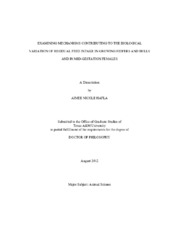| dc.description.abstract | The objectives of this study were to characterize residual feed intake (RFI) in growing bulls and heifers and in mid-gestation females to examine relationships with performance, body composition, feeding behavior, digestibility (DMD) and heart rate (HR) and evaluate the impact of RFI on bull fertility and cow forage utilization. Additionally, use of the n-alkane method to predict individual animal variations in intake was investigated. To accomplish these objectives, multiple RFI studies were conducted. In all studies RFI was computed as the difference between actual and expected DMI from linear regression of DMI on mid-test metabolic BW and ADG.
To evaluate phenotypic relationships between feed efficiency, scrotal circumference (SC) and semen-quality an experiment was conducted with yearling bulls (N=204). Residual feed intake was not correlated with BW and ADG, but was positively associated with 12th-rib back fat (BF) such that the more efficient bulls were leaner. Bulls with low RFI had similar SC and progressive motility of sperm compared to high-RFI bulls. However percent normal sperm were weakly associated with RFI in a negative manner.
To examine phenotypic relationships between heifer postweaning RFI, and performance, efficiency, HR, and DMD of mid-gestation cows, RFI was measured in growing Bonsmara heifers (N=175). Forty-eight heifers with divergent RFI were retained for breeding. Subsequently, intake, performance and feeding behavior was measured on mid-gestation females. Pregnant females classified as having low postweaning RFI continued to consume 22% less feed, spent 25% less time eating, and had 7% lower HR while maintaining similar BW, ADG and body composition compared to high RFI females. A moderate association between RFI in growing heifers and subsequent efficiency of forage utilization in pregnant cows was found. Growing heifers identified as efficient had greater DMD, however DMD in mature cows was similar between RFI groups. The n-alkane method of predicting intake detected differences in intake between divergent RFI groups in mid-gestation females.
Results from this study indicate that inclusion of RFI as a component of a multi-trait selection program will improve feed efficiency of growing animals and mid-gestation females with minimal impacts on growth, body composition, and fertility traits. | en |


